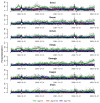Effects of Air Pollution on Asthma Hospitalization Rates in Different Age Groups in Metropolitan Cities of Korea
- PMID: 24223075
- PMCID: PMC3821782
- DOI: 10.1007/s11869-013-0195-x
Effects of Air Pollution on Asthma Hospitalization Rates in Different Age Groups in Metropolitan Cities of Korea
Abstract
Many studies have shown associations between air pollution and asthma admissions in Korea, but have not reported whether these effects differ by age classification. The purpose of this study was to determine whether air pollution effects on asthmatic hospital admissions are different by three age groups (years): children (less than 15), adults (15-64; reference group), and the elderly (over 65). Daily time-series data from seven metropolitan cities in South Korea were analyzed in two stages. In the first stage, relative asthma morbidity rates associated with air pollution were estimated for each city and age group, using semi-parametric log-linear regression. In the second stage, estimates from all seven cities were combined by age group using Bayesian hierarchical modeling. The effects of exposure to particulate matter <10 micrometers in aerodynamic diameter (PM10), carbon monoxide (CO) and nitrogen dioxide (NO2) varied significantly by age groups. Using adults as the referent, the relative rate (RR) of asthma admissions with 10μg/m3 increase of PM10 is 1.5% (95%CI: 0.1-2.8%) lower for children, and 1.3% (95% CI: 0.7-1.9%) higher for the elderly; RR with 1ppm increase of CO is 1.9% (95% CI: 0.3-3.8%) lower for children; RR with 1ppb increase of NO2(1ppb) is 0.5% (95% CI: 0.3-0.7%) higher for the elderly. No significant age group difference in relative rate was found for ozone or sulfur dioxide.
Figures



References
-
- Abe T, Tokuda Y, Ohde S, Ishimatsu S, Nakamura T, Birrer RB. The relationship of short-term air pollution and weather to ED visits for asthma in japan. The American Journal of Emergency Medicine. 2009;27(2):153–159. - PubMed
-
- Anderson HR, Ruggles R, Pandey KD, Kapetanakis V, Brunekreef B, Lai CK, et al. Ambient particulate pollution and the world-wide prevalence of asthma, rhinoconjunctivitis and eczema in children: Phase one of the international study of asthma and allergies in childhood (ISAAC) Occupational and Environmental Medicine. 2010;67(5):293–300. - PubMed
-
- Atkinson RW, Anderson HR, Sunyer J, Ayres J, Baccini M, Vonk JM, et al. Acute effects of particulate air pollution on respiratory admissions: Results from APHEA 2 project. air pollution and health: A european approach. American Journal of Respiratory and Critical Care Medicine. 2001;164(10 Pt 1):1860–1866. - PubMed
-
- Baibergenova A, Thabane L, Akhtar-Danesh N, Levine M, Gafni A, Moineddin R, et al. Effect of gender, age, and severity of asthma attack on patterns of emergency department visits due to asthma by month and day of the week. European Journal of Epidemiology. 2005;20(11):947–956. - PubMed
Grants and funding
LinkOut - more resources
Full Text Sources
Other Literature Sources
